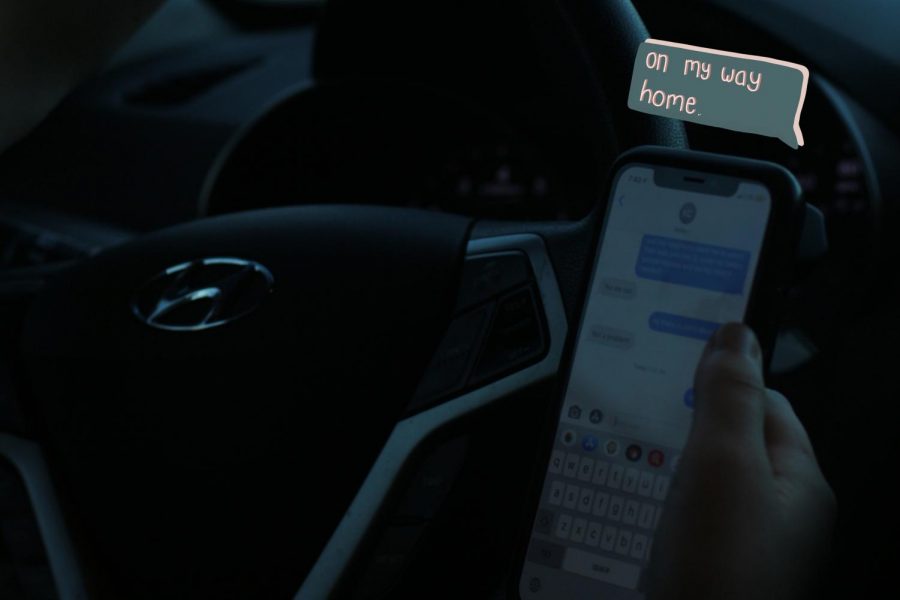Be home soon
In 2017, 3,166 people were killed as a result of distracted driving.
According to the National Highway Traffic Safety Administration (NHTSA), nearly 20,000 people died in crashes involving a distracted driver from 2012 to 2017. Although distracted driving has decreased since 2016, the problem has not gone away. In 2017, 3,166 people were killed as a result of distracted driving.
Ramina Melikova, sophomore, saw the effects of distracted driving when her stepmother got into a car accident. The driver who rear-ended her was distracted by Girl Scouts selling cookies on a street corner. Melikova was shocked.
Although it was a minor crash, Melikova’s stepmother has dealt with pain in her neck, shoulders and upper back that has lasted for over a year. Even though the distracted driver that hit her stepmother was not preoccupied by a phone, Melikova wants to see changes in policy on texting and driving because she believes people’s lives are at stake.
“Whether it [is] from distracted driving by texting, calling, FaceTiming, being on Snapchat [or] social media; just that can kill someone,” Melikova said. “[Distracted driving] can cause severe pain [or] chronic pain.”
Donald Douglas, KHS resource officer, said there has been a shift in what distracted driving looks like from when he was in high school. Douglas said friends used to be a distraction, but cell phones make it harder to resist distracted driving. In 2016, 9% of drivers age 15-19 that were involved in a fatal accident were distracted. In 14% of those crashes, a cell phone was involved. He said texting and driving is dangerous, but recognizes that phones can be hard to put down.
“Don’t [text and drive],” Douglas said. “I know everybody wants to talk to everyone right away, but there are features on your phone where you can turn [notifications] off for the time you are driving or it’s in gear.”
Douglas said the city of Kirkwood has a hands-free policy, which means you can not text and drive, nor use one hand to hold a cell phone. According to the St. Louis Post Dispatch, the policy went into effect in 2014.
“In Kirkwood, you can get a ticket or a fine,” Douglas said. “It’s not even [just] texting. If you have an electronic device [or] a phone in your hand, we can pull you over.”
The hands-free policy does not apply to all of Missouri. According to KMOX news radio, Missouri and Montana are the only remaining states that do not ban texting while driving. However, Missouri has a law that bans texting and driving for people under 21.
Melikova said texting and driving should be more regulated. She believes changes in technology could help prevent accidents.
“I feel like there should be more features on phones and on cars that restrict [texting and driving],” Melikova said. “They should limit phone usage to the point where you can’t access your phone at times when you’re driving.”
Apple’s iOS 11 software includes a mode called Do Not Disturb While Driving, which is an optional feature that silences any notifications, text messages, or calls when the phone detects that it is in a moving vehicle. The mode can be activated manually, when connected to a car’s bluetooth, or automatically when an iPhone detects that the owner may be driving.
Melikova is not alone in thinking that technology can be used to help prevent texting and driving. Gio Vann, sophomore, said he knows many people who text and drive, and wants a solution. When he is in the car with distracted drivers, Vann said he attempts to stop them by taking their phones or texting for them, but the phones are addictive.
“[Texting and driving] gives me a bad vision of something happening next,” Vann said. “Because I [have] anxiety and stuff like that, I would probably get scared and think that we’re going to crash. I would try to act fast.”
Melikova believes even the most experienced drivers can end up in a crash. According to the NHSTA, looking away from the road for five seconds going 55 mph means that one can travel the length of a football field without being aware of their surroundings.
“I feel like it’s very selfish to text and drive,” Melikova said. “Because not only are you putting your own life at risk, you’re putting other people’s lives at risk. Once you do that, you’re crossing a big boundary.”
Your donation will support the student journalists of Kirkwood High School. Your contribution will allow us to purchase equipment and cover our annual website hosting costs.

she/her
Hobbies and Interests: Playing/writing/listening to music, politics, exploring
Favorite Song: “Bad (Live)” by U2
Favorite Quote: “Life...

Interests: Singing with my band, hanging with friends, going to the lake sometimes.
Favorite musical artist: Thomas Rhett prolly.
Favorite quote:...















